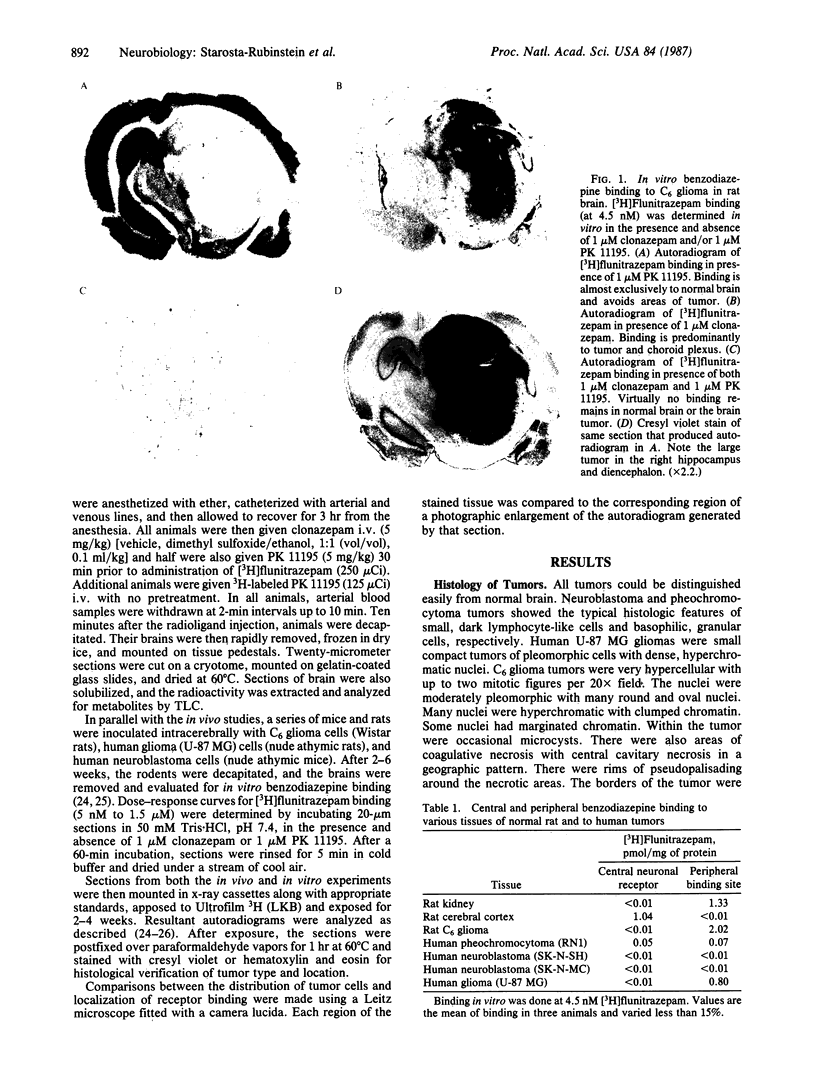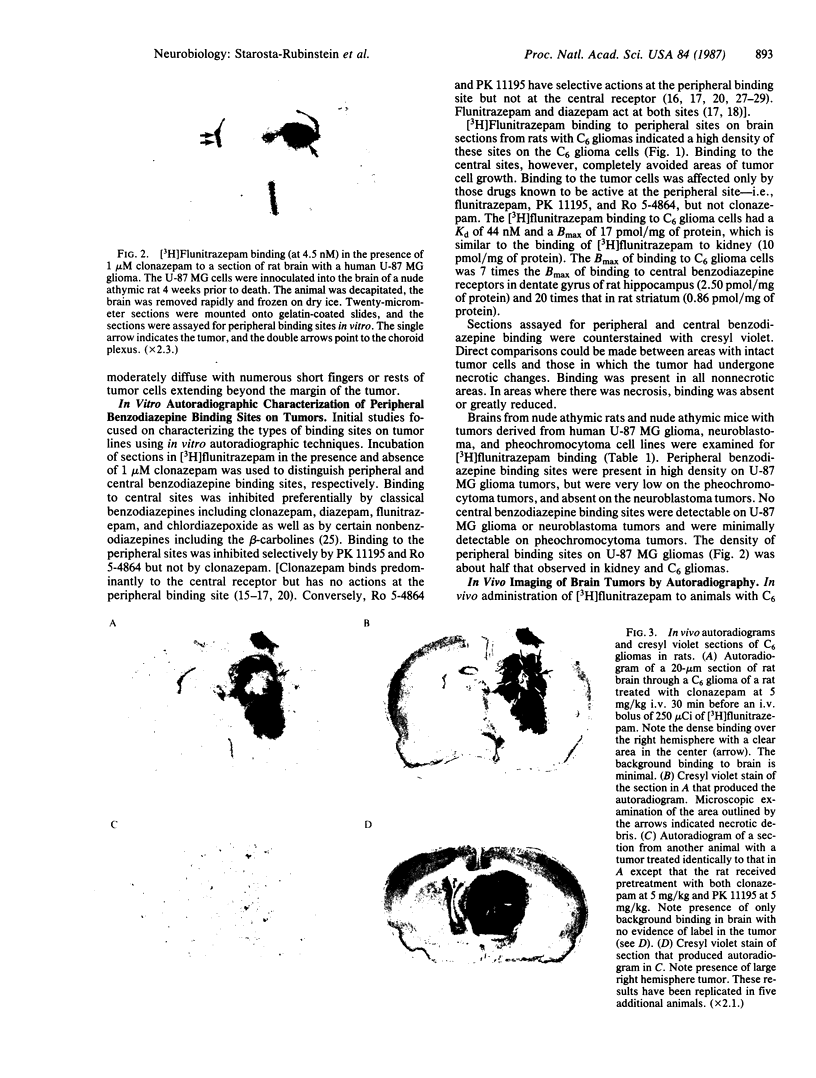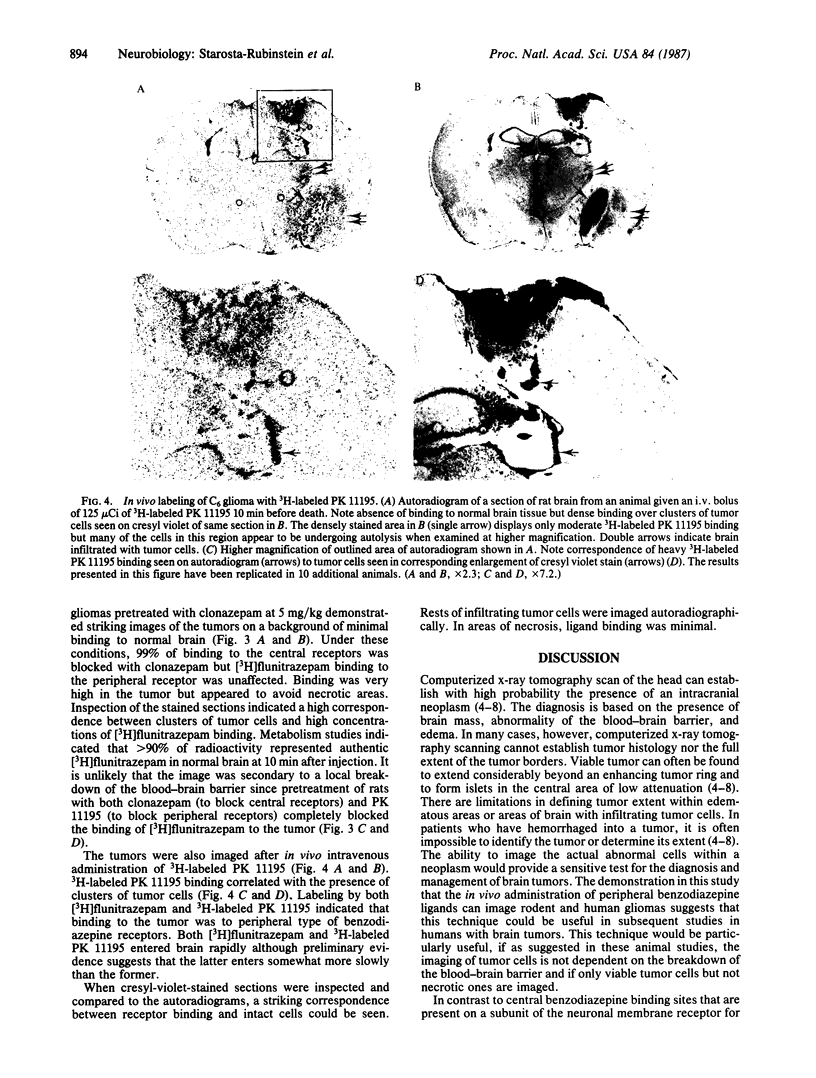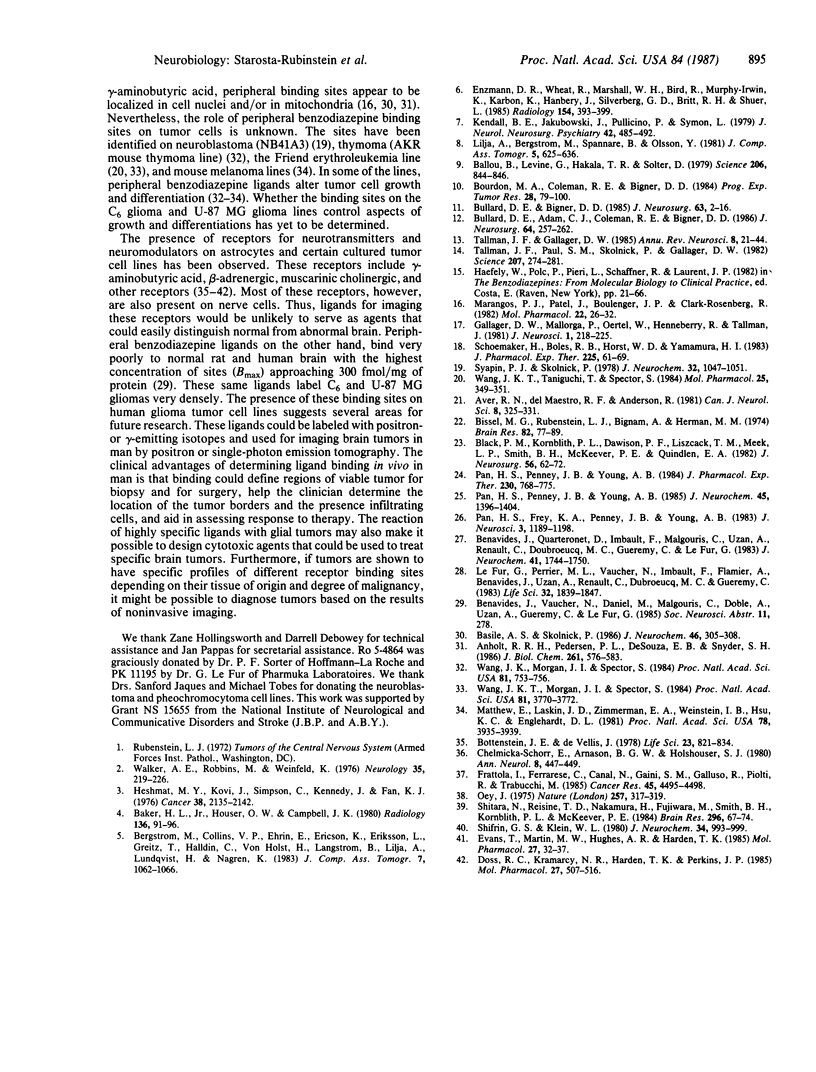Abstract
Two types of benzodiazepine receptors have been demonstrated in mammalian tissues, one which is localized on neuronal elements in brain and the other, on glial cells and in peripheral tissues such as kidney. In vivo administration of 3H-labeled PK 11195 [1-(2-chlorophenyl-N-methyl-N-(1-methylpropyl)-3-isoquinoline carboxamide] or [3H]flunitrazepam with 5 mg of clonazepam per kg to rats with intracranial C6 gliomas resulted in high levels of tritiated-drug binding to the tumor as shown by quantitative autoradiography. Pharmacological studies indicated that the bound drugs labeled the peripheral benzodiazepine binding site. Binding to the peripheral benzodiazepine site was confirmed primarily to malignant cells with little binding to adjacent normal brain tissue or to necrotic tissue. Tumor cell binding was completely inhibited by preadministration of the peripheral benzodiazepine blocking agent PK 11195 at 5 mg/kg. The centrally selective benzodiazepine ligand clonazepam had no effect on PK 11195 binding to the tumor cells. When binding to other tumor cell lines grown in nude mice and nude athymic rats was evaluated, little or no peripheral benzodiazepine binding was detected on human pheochromocytoma (RN1) and neuroblastoma (SK-N-MC, SK-N-SH) tumor cells, respectively. However, high densities of peripheral benzodiazepine binding sites were observed on tumors derived from a human glioma cell line (ATCC HTB 14, U-87 MG). The presence of high concentrations of specific peripheral benzodiazepine receptors on glial tumors suggests that human primary central nervous system tumors could be imaged and diagnosed using peripheral benzodiazepine ligands labeled with positron- or gamma-emitting isotopes.
Full text
PDF




Images in this article
Selected References
These references are in PubMed. This may not be the complete list of references from this article.
- Anholt R. R., Pedersen P. L., De Souza E. B., Snyder S. H. The peripheral-type benzodiazepine receptor. Localization to the mitochondrial outer membrane. J Biol Chem. 1986 Jan 15;261(2):576–583. [PubMed] [Google Scholar]
- Auer R. N., Del Maestro R. F., Anderson R. A simple and reproducible experimental in vivo glioma model. Can J Neurol Sci. 1981 Nov;8(4):325–331. doi: 10.1017/s0317167100043468. [DOI] [PubMed] [Google Scholar]
- Baker H. L., Jr, Houser O. W., Campbell J. K. National Cancer Institute study: evaluation of computed tomography in the diagnosis of intracranial neoplasms. I. Overall results. Radiology. 1980 Jul;136(1):91–96. doi: 10.1148/radiology.136.1.7384529. [DOI] [PubMed] [Google Scholar]
- Ballou B., Levine G., Hakala T. R., Solter D. Tumor location detected with radioactively labeled monoclonal antibody and external scintigraphy. Science. 1979 Nov 16;206(4420):844–847. doi: 10.1126/science.493985. [DOI] [PubMed] [Google Scholar]
- Basile A. S., Skolnick P. Subcellular localization of "peripheral-type" binding sites for benzodiazepines in rat brain. J Neurochem. 1986 Jan;46(1):305–308. doi: 10.1111/j.1471-4159.1986.tb12965.x. [DOI] [PubMed] [Google Scholar]
- Benavides J., Quarteronet D., Imbault F., Malgouris C., Uzan A., Renault C., Dubroeucq M. C., Gueremy C., Le Fur G. Labelling of "peripheral-type" benzodiazepine binding sites in the rat brain by using [3H]PK 11195, an isoquinoline carboxamide derivative: kinetic studies and autoradiographic localization. J Neurochem. 1983 Dec;41(6):1744–1750. doi: 10.1111/j.1471-4159.1983.tb00888.x. [DOI] [PubMed] [Google Scholar]
- Bergström M., Collins V. P., Ehrin E., Ericson K., Eriksson L., Greitz T., Halldin C., von Holst H., Långström B., Lilja A. Discrepancies in brain tumor extent as shown by computed tomography and positron emission tomography using [68Ga]EDTA, [11C]glucose, and [11C]methionine. J Comput Assist Tomogr. 1983 Dec;7(6):1062–1066. doi: 10.1097/00004728-198312000-00022. [DOI] [PubMed] [Google Scholar]
- Bissell M. G., Rubinstein L. J., Bignami A., Herman M. M. Characteristics of the rat C-6 glioma maintained in organ culture systems. Production of glial fibrillary acidic protein in the absence of gliofibrillogenesis. Brain Res. 1974 Dec 20;82(1):77–89. doi: 10.1016/0006-8993(74)90894-4. [DOI] [PubMed] [Google Scholar]
- Black P. M., Kornblith P. L., Davison P. F., Liszczak T. M., Merk L. P., Smith B. H., McKeever P. E., Quindlen E. A. Immunological, biochemical, ultrastructural, and electrophysiological characteristics of a human glioblastoma-derived cell culture line. J Neurosurg. 1982 Jan;56(1):62–72. doi: 10.3171/jns.1982.56.1.0062. [DOI] [PubMed] [Google Scholar]
- Bottenstein J. E., de Vellis J. Regulation of cyclic GMP, cyclic AMP and lactate dehydrogenase by putative neurotransmitters in the C6 rat glioma cell line. Life Sci. 1978 Aug 28;23(8):821–834. doi: 10.1016/0024-3205(78)90517-9. [DOI] [PubMed] [Google Scholar]
- Bourdon M. A., Coleman R. E., Bigner D. D. The potential of monoclonal antibodies as carriers of radiation and drugs for immunodetection and therapy of brain tumors. Prog Exp Tumor Res. 1984;28:79–101. doi: 10.1159/000408239. [DOI] [PubMed] [Google Scholar]
- Bullard D. E., Adams C. J., Coleman R. E., Bigner D. D. In vivo imaging of intracranial human glioma xenografts comparing specific with nonspecific radiolabeled monoclonal antibodies. J Neurosurg. 1986 Feb;64(2):257–262. doi: 10.3171/jns.1986.64.2.0257. [DOI] [PubMed] [Google Scholar]
- Bullard D. E., Bigner D. D. Applications of monoclonal antibodies in the diagnosis and treatment of primary brain tumors. J Neurosurg. 1985 Jul;63(1):2–16. doi: 10.3171/jns.1985.63.1.0002. [DOI] [PubMed] [Google Scholar]
- Chelmicka-Schorr E., Arnason B. G., Holshouser S. J. C-6 glioma growth in rats: suppression with a beta-adrenergic agonist and a phosphodiesterase inhibitor. Ann Neurol. 1980 Oct;8(4):447–449. doi: 10.1002/ana.410080421. [DOI] [PubMed] [Google Scholar]
- Doss R. C., Kramarcy N. R., Harden T. K., Perkins J. P. Effects of tunicamycin on the expression of beta-adrenergic receptors in human astrocytoma cells during growth and recovery from agonist-induced down-regulation. Mol Pharmacol. 1985 May;27(5):507–516. [PubMed] [Google Scholar]
- Enzmann D. R., Wheat R., Marshall W. H., Bird R., Murphy-Irwin K., Karbon K., Hanbery J., Silverberg G. D., Britt R. H., Shuer L. Tumors of the central nervous system studied by computed tomography and ultrasound. Radiology. 1985 Feb;154(2):393–399. doi: 10.1148/radiology.154.2.3880911. [DOI] [PubMed] [Google Scholar]
- Evans T., Martin M. W., Hughes A. R., Harden T. K. Guanine nucleotide-sensitive, high affinity binding of carbachol to muscarinic cholinergic receptors of 1321N1 astrocytoma cells is insensitive to pertussis toxin. Mol Pharmacol. 1985 Jan;27(1):32–37. [PubMed] [Google Scholar]
- Frattola L., Ferrarese C., Canal N., Gaini S. M., Galluso R., Piolti R., Trabucchi M. Characterization of the gamma-aminobutyric acid receptor system in human brain gliomas. Cancer Res. 1985 Sep;45(9):4495–4498. [PubMed] [Google Scholar]
- Gallager D. W., Mallorga P., Oertel W., Henneberry R., Tallman J. [3H]Diazepam binding in mammalian central nervous system: a pharmacological characterization. J Neurosci. 1981 Feb;1(2):218–225. doi: 10.1523/JNEUROSCI.01-02-00218.1981. [DOI] [PMC free article] [PubMed] [Google Scholar]
- Heshmat M. Y., Kovi J., Simpson C., Kennedy J., Fan K. J. Neoplasms of the central nervous system. incidence and population selectivity in the Washington DC, metropolitan area. Cancer. 1976 Nov;38(5):2135–2142. doi: 10.1002/1097-0142(197611)38:5<2135::aid-cncr2820380543>3.0.co;2-t. [DOI] [PubMed] [Google Scholar]
- Kendall B. E., Jakubowski J., Pullicino P., Symon L. Difficulties in diagnosis of supratentorial gliomas by CAT scan. J Neurol Neurosurg Psychiatry. 1979 Jun;42(6):485–492. doi: 10.1136/jnnp.42.6.485. [DOI] [PMC free article] [PubMed] [Google Scholar]
- Le Fur G., Perrier M. L., Vaucher N., Imbault F., Flamier A., Benavides J., Uzan A., Renault C., Dubroeucq M. C., Guérémy C. Peripheral benzodiazepine binding sites: effect of PK 11195, 1-(2-chlorophenyl)-N-methyl-N-(1-methylpropyl)-3-isoquinolinecarboxamide. I. In vitro studies. Life Sci. 1983 Apr 18;32(16):1839–1847. doi: 10.1016/0024-3205(83)90062-0. [DOI] [PubMed] [Google Scholar]
- Lilja A., Bergström K., Spännare B., Olsson Y. Reliability of computed tomography in assessing histopathological features of malignant supratentorial gliomas. J Comput Assist Tomogr. 1981 Oct;5(5):625–636. [PubMed] [Google Scholar]
- Marangos P. J., Patel J., Boulenger J. P., Clark-Rosenberg R. Characterization of peripheral-type benzodiazepine binding sites in brain using [3H]Ro 5-4864. Mol Pharmacol. 1982 Jul;22(1):26–32. [PubMed] [Google Scholar]
- Matthew E., Laskin J. D., Zimmerman E. A., Weinstein I. B., Hsu K. C., Engelhardt D. L. Benzodiazepines have high-affinity binding sites and induce melanogenesis in B16/C3 melanoma cells. Proc Natl Acad Sci U S A. 1981 Jun;78(6):3935–3939. doi: 10.1073/pnas.78.6.3935. [DOI] [PMC free article] [PubMed] [Google Scholar]
- Oey J. Noradrealine induces morphological alterations in nucleated and enucleated rat C6 glioma cells. Nature. 1975 Sep 25;257(5524):317–319. doi: 10.1038/257317a0. [DOI] [PubMed] [Google Scholar]
- Pan H. S., Frey K. A., Young A. B., Penney J. B., Jr Changes in [3H]muscimol binding in substantia nigra, entopeduncular nucleus, globus pallidus, and thalamus after striatal lesions as demonstrated by quantitative receptor autoradiography. J Neurosci. 1983 Jun;3(6):1189–1198. doi: 10.1523/JNEUROSCI.03-06-01189.1983. [DOI] [PMC free article] [PubMed] [Google Scholar]
- Pan H. S., Penney J. B., Jr, Young A. B. Characterization of benzodiazepine receptor changes in substantia nigra, globus pallidus and entopeduncular nucleus after striatal lesions. J Pharmacol Exp Ther. 1984 Sep;230(3):768–775. [PubMed] [Google Scholar]
- Pan H. S., Penney J. B., Young A. B. Gamma-aminobutyric acid and benzodiazepine receptor changes induced by unilateral 6-hydroxydopamine lesions of the medial forebrain bundle. J Neurochem. 1985 Nov;45(5):1396–1404. doi: 10.1111/j.1471-4159.1985.tb07205.x. [DOI] [PubMed] [Google Scholar]
- Schoemaker H., Boles R. G., Horst W. D., Yamamura H. I. Specific high-affinity binding sites for [3H]Ro 5-4864 in rat brain and kidney. J Pharmacol Exp Ther. 1983 Apr;225(1):61–69. [PubMed] [Google Scholar]
- Shifrin G. S., Klein W. L. Regulation of muscarinic acetylcholine receptor concentration in cloned neuroblastoma cells. J Neurochem. 1980 Apr;34(4):993–999. doi: 10.1111/j.1471-4159.1980.tb09676.x. [DOI] [PubMed] [Google Scholar]
- Shitara N., Reisine T. D., Nakamura H., Fujiwara M., Smith B. H., Kornblith P. L., McKeever P. E. The beta-adrenergic receptor system in human glioma-derived cell lines: the mode of phosphodiesterase induction and the macromolecules phosphorylated by cyclic AMP-dependent protein kinase. Brain Res. 1984 Mar 26;296(1):67–74. doi: 10.1016/0006-8993(84)90511-0. [DOI] [PubMed] [Google Scholar]
- Syapin P. J., Skolnick P. Characterization of benzodiazepine binding sites in cultured cells of neural origin. J Neurochem. 1979 Mar;32(3):1047–1051. doi: 10.1111/j.1471-4159.1979.tb04592.x. [DOI] [PubMed] [Google Scholar]
- Tallman J. F., Gallager D. W. The GABA-ergic system: a locus of benzodiazepine action. Annu Rev Neurosci. 1985;8:21–44. doi: 10.1146/annurev.ne.08.030185.000321. [DOI] [PubMed] [Google Scholar]
- Tallman J. F., Paul S. M., Skolnick P., Gallager D. W. Receptors for the age of anxiety: pharmacology of the benzodiazepines. Science. 1980 Jan 18;207(4428):274–281. doi: 10.1126/science.6101294. [DOI] [PubMed] [Google Scholar]
- Walker A. E., Robins M., Weinfeld F. D. Epidemiology of brain tumors: the national survey of intracranial neoplasms. Neurology. 1985 Feb;35(2):219–226. doi: 10.1212/wnl.35.2.219. [DOI] [PubMed] [Google Scholar]
- Wang J. K., Morgan J. I., Spector S. Benzodiazepines that bind at peripheral sites inhibit cell proliferation. Proc Natl Acad Sci U S A. 1984 Feb;81(3):753–756. doi: 10.1073/pnas.81.3.753. [DOI] [PMC free article] [PubMed] [Google Scholar]
- Wang J. K., Morgan J. I., Spector S. Differentiation of Friend erythroleukemia cells induced by benzodiazepines. Proc Natl Acad Sci U S A. 1984 Jun;81(12):3770–3772. doi: 10.1073/pnas.81.12.3770. [DOI] [PMC free article] [PubMed] [Google Scholar]
- Wang J. K., Taniguchi T., Spector S. Structural requirements for the binding of benzodiazepines to their peripheral-type sites. Mol Pharmacol. 1984 May;25(3):349–351. [PubMed] [Google Scholar]















